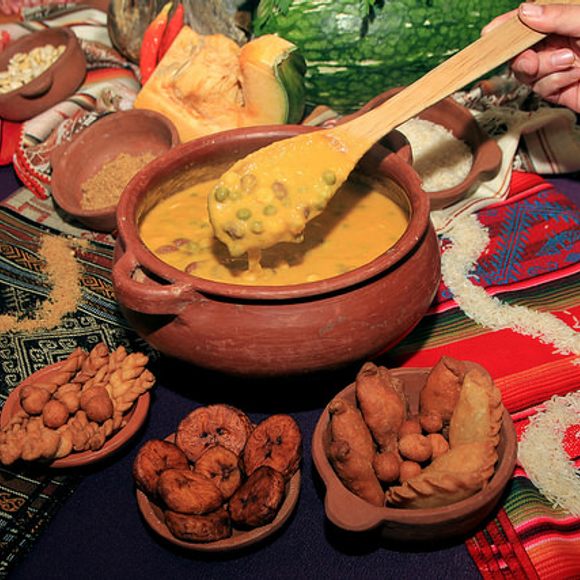There are plenty of simple soups out there. Fanesca, a rich mélange found only in the Ecuadorian Sierra, is anything but. Featuring dozens of ingredients, many unique to the region, it is so connected to the Easter season—and so time-consuming to prepare—that it graces tables only for a brief period each year.
Fanesca’s thick base covers three separate food groups all on its own: It’s made out of salt cod, cooked in milk, and thickened with pumpkin seeds or peanuts. Then chefs add up to a dozen different beans, vegetables, and grains; one, some say, for each of the twelve apostles.
Each fanesca-maker has a unique veggie-and-legume lineup. Some even hand-peel each individual bean and kernel of corn, but popular choices include peas, pumpkin, lupini beans, and hominy. When the soup’s finished, it’s time to float in some garnishes, which often include hard-boiled eggs, chunks of plantain, and miniature empanadas. The result is a diversely textured and flavored soup that’s the color of a setting sun and thick enough to cling to a spoon.
There are a few different fanesca origin stories. One holds that it was invented in ancient Rome by persecuted Christians who snuck into the catacombs with sacks of grain and legumes to cook the soup in one enormous pot. Another story traces it to the pre-Columbian Andes, where people celebrated the bounty of the harvest by putting much of said bounty into one soup. In this telling, the Christian interpretation was added after Spanish colonization.
Many centuries later, you can find people husking corn and peeling beans, cleaning and chopping vegetables, and presoaking salt cod as soon as Lent starts winding down. The city of Quito even has an annual fanesca competition entered by hundreds of restaurants. By Holy Thursday, you can be pretty sure that almost everyone in the area is tucking into a bowl. After all, the memory has to last for the rest of the year.
Where to Try It
-
Hotel Mercure Alameda Quito
Vicente Ramón Roca E4-122, Quito, EC170526, EcuadorThis hotel's fanesca regularly places in the top 12 in Quito's annual fanesca competition.
Written By
 Cara Giaimo
Cara Giaimo
Sources
- www.newyorker.com/magazine/2005/09/05/speaking-of-soup
- www.npr.org/sections/thesalt/2017/03/02/517969323/ecuadors-fanesca-is-a-lenten-soup-flavored-with-centuries-of-tradition
- books.google.com/books?id=LlePAePLlqkC&q=fanesca#v=snippet&q=fanesca&f=false
- www.tucantravel.com/blog/2015/04/feasting-on-fanesca-easter-in-ecuador/
The Atlas Obscura Podcast is Back!
















